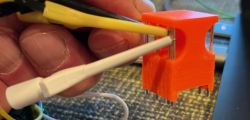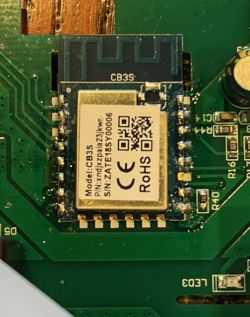Hi All,
I'm trying to flash an SM-301-U-PA20 Xenon powerstrip that uses a CB3S chip. I'm not excited about soldering so I've been trying to use the pogopin jig that I use to flash many of my ESP8266-ish devices. So far, I've had no luck. I'm using ltchiptool, trying to just get the chip info or read the flash.
Here's the jig:
I figured, based on comments in the forum and the GitHub issues, that something else on the board was getting in my way and had given up.
Looking around this forum, I see a couple of references to folks flashing very similar devices by soldering to the board (e.g. https://www.elektroda.com/rtvforum/topic3963570.html#20479666 by @gcole) so I've been thinking again about what's been giving me problems.
There's some sort of goop over the contacts on the chip (see photo), I thought it was left over from the soldering process, but I'm wondering if it's epoxy or something that's intended to prevent people like me from getting access?

If I put probes from a multimeter between the 3.3v and the ground pins on the chip, should I see conductivity (a circuit)? I'm not, which makes me suspect that I'm not actually touching the pins....
Thank you for any suggestions!
g.
Added after 37 [minutes]:
A bit more exploring with my meter's continuity mode. I can hold a probe onto the metal shell of the module and the ground pin and get a signal, and I can find pins elsewhere on the board that also give me a beep. So, it seems like the probe is making a reasonable connection to the chip.
Likewise, I can hold a pin to the 3.3v pin and explore various chips. Some of them report values that change when I apply/remove the probe to the 3.3v pin (not sure if it's measuring ohms of resistance or ???). I never get a beep, but since the value changes I assume I'm making contact.
This all suggests that the chip hasn't been tamper-proofed and something else is going wrong. Suggestions?
I'm trying to flash an SM-301-U-PA20 Xenon powerstrip that uses a CB3S chip. I'm not excited about soldering so I've been trying to use the pogopin jig that I use to flash many of my ESP8266-ish devices. So far, I've had no luck. I'm using ltchiptool, trying to just get the chip info or read the flash.
Here's the jig:

I figured, based on comments in the forum and the GitHub issues, that something else on the board was getting in my way and had given up.
Looking around this forum, I see a couple of references to folks flashing very similar devices by soldering to the board (e.g. https://www.elektroda.com/rtvforum/topic3963570.html#20479666 by @gcole) so I've been thinking again about what's been giving me problems.
There's some sort of goop over the contacts on the chip (see photo), I thought it was left over from the soldering process, but I'm wondering if it's epoxy or something that's intended to prevent people like me from getting access?

If I put probes from a multimeter between the 3.3v and the ground pins on the chip, should I see conductivity (a circuit)? I'm not, which makes me suspect that I'm not actually touching the pins....
Thank you for any suggestions!
g.
Added after 37 [minutes]:
A bit more exploring with my meter's continuity mode. I can hold a probe onto the metal shell of the module and the ground pin and get a signal, and I can find pins elsewhere on the board that also give me a beep. So, it seems like the probe is making a reasonable connection to the chip.
Likewise, I can hold a pin to the 3.3v pin and explore various chips. Some of them report values that change when I apply/remove the probe to the 3.3v pin (not sure if it's measuring ohms of resistance or ???). I never get a beep, but since the value changes I assume I'm making contact.
This all suggests that the chip hasn't been tamper-proofed and something else is going wrong. Suggestions?






